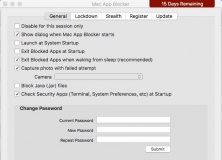


Most of these only test Windows versions but it is still a very good measure of anti-malware software for Macs because most threats are shared by the different operating systems. It regularly comes in dead last in SE Labs and other security tests. Sometimes security lab and editorial software reviews can provide more information about what they are good at protecting against.įrankly, I think that Malwarebytes is the last program that I would recommend to protect Macs. Unfortunately, it can be difficult to ascertain much information regarding them because the companies tend to be rather vague about the specifics. Some commercial programs have predictive analysis functions that may provide protection against previously unknown malware. some are better than others, in some cases by a wide margin. However, the frequency of security data updates can vary greatly among commercial programs i.e. To be fair, so would any other commercial anti-malware products that rely on Virus Total and already identified threats and the software has not been updated. If you use the paid version, your Mac will still be vulnerable until Malwarebytes updates and pushes the necessary data to your Mac. And that would only happen if you had the paid version which should continually scan for potential threats. It depends on whether Malwarebytes is designed to identify and immediately intervene with this type of malware. I would hope that it would be effective if its virus signature data was updated and automatically downloaded to your Mac before the malware was installed. If that is the case, Malwarebytes would be useless if your Mac was infected prior to you running a scan.
Vallum mac review manual#
Since you state that you perform manual scans "every few days" it sounds like you are using the free version of Malwarebytes. Have you ever found any notice of malware? Is Malwarebytes working without going through any upgrade? Is it going to spot Made in China: OSX.ZuRu?

Philip Eihuyar wrote: A couple of questions- I installed Malwarebytes some time ago and never once have been notified off any malware. Is LuLu -in your experience- an easy app to use? Has it tagged any problems? Lulu is the first Objective-See utility I discovered a couple of years ago and it is installed on all of our Macs.Ī couple of questions- I installed Malwarebytes some time ago and never once have been notified off any malware. This is another example why certain third-party anti-malware utilities are very useful additions to the built-in security protections of the Mac OS. The second alert is for the attempted exfiltration of the pilfered data to a remote server. That's two warnings that something is amiss and the user should seriously reconsider what they are about to do. At the time the article was posted September 14, neither the installer disk image nor an enclosed dylib was flagged by any of the anti-virus engines on VirusTotal as malicious.įortunately, Lulu successfully flags and displays alerts for two outbound connection attempts by the malware. Patrick goes into a lot of detail about how the malware works and what it does once it is installed on a Mac. It's easy to configure the additional domains so visitors wind up at your primary active website if they input another related URL by mistake. I don't enjoy spending the extra dough but I make a habit of doing it with my important domains. This is a good lesson why it is worth registering variations of a.
Vallum mac review Offline#
(I tried connecting to the imposter website but DNS resolving is unsuccessful the website has been offline since September 15.) This link is the Real Deal the bogus malicious website replaces. The malware is installed via links on a website that pretends to host the popular Terminal emulator iTerm2. A recent post on Patrick Wardle's blog entitled Made in China: OSX.ZuRuis about the discovery of Mac malware that steals various things including the infected system's keychain.


 0 kommentar(er)
0 kommentar(er)
